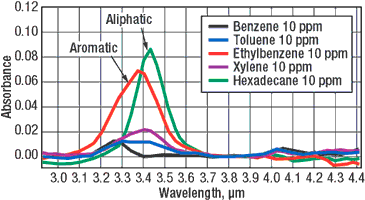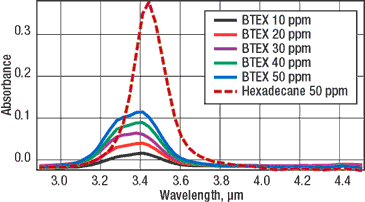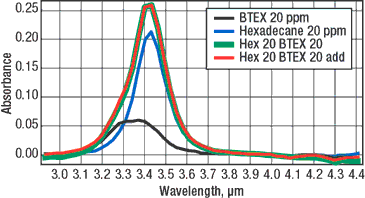|
Vol. 227 No. 1 2 |
| |
 |
New infrared methods for analyzing produced water
With some solvents banned, different regulations apply in various countries, each with different methodologies.
Sandy Rintoul, Wilks Enterprise, Inc.; South Norwalk, Connecticut
Infrared methods for detecting oil in water have been highly useful in oilfield applications for over 20 years. A simple method, a solvent is added to the produced water, which then absorbs the oil. When the solvent sample is exposed to infrared light, the amount of infrared light that is absorbed provides the oil in water measurement. With the manufacture of Freon 113 banned by the Montreal Protocol in 1995, the old ASTM method (D 3921) that used infrared analysis and Freon 113 had to be replaced. These replacements are being refined. The latest updates are discussed.
NEW ASTM METHOD D7066-04
Numerous oil and grease applications including EPA Methods 413.2 and 418.1 and ASTM Method D 3921 used Freon as the extraction solvent. Freon 113 has two key characteristics that made it ideal for use as the solvent in Method 418.1: Hydrocarbons have a high solubility in Freon 113 and it is infrared transparent in the spectral region where hydrocarbons absorb. In addition, it is non-toxic and relatively non-volatile. Finding a comparable solvent to Freon was the most difficult task faced by the ASTM committee when asked by the US’ EPA to develop a new method with a new solvent.
Several different solvents have been studied as replacements. The British DTI has permitted the temporary use of tetrachloroethylene (TTCE) or perchloroethylene (perc) as a replacement solvent. This material is infrared transparent. However, there is concern about its potential toxicity. EPA has selected n-hexane for its gravimetric procedure, EPA Method 1664-A. Since hexane is not infrared transparent, it must be evaporated before its residue can be examined by infrared to determine hydrocarbon concentration. Because of the evaporation stage for both gravimetric and infrared methods, hexane extraction does not measure volatile hydrocarbons. The Scandinavian countries have accepted pentane, which has similar characteristics as hexane, as their solvent of choice.
EPA wanted a method that would measure volatile constituents and be portable enough for platform and field analysis. They requested the ASTM to create a new method using an alternate solvent suitable for an infrared transmission measurement. Accordingly, subcommittee D19-06 was formed in 2002 to replace ASTM D3921, “Standard Test Method for Oil and Grease and Petroleum Hydrocarbons in Water,” with a method to accommodate an alternate solvent to Freon 113.
After evaluating potential candidates, the committee tested two solvents for the round robin: Dichloro-pentafluorpropane (Asahiklin AK-225) and dimer/ trimer of chlorotrifluoroethylene (Horiba S-316). Perchloroethylene was not even considered, as it is on the Montreal Protocol list to be banned in 2030. The method submitted for approval used S-316 as the extraction solvent. As there was not enough data for the precision and bias statement for the AK-225, the ASTM committee included data for AK-225 in an appendix to the committee report to encourage other interested organizations to perform their own round robin if they would like to use AK-225. ASTM Method D7066-04 Test Method for dimer/ trimer of chlorotrifluoroethylene (S-316), “Recoverable Oil and Grease and Nonpolar Material by Infrared Determination,” was passed and published in July 2004. The EPA’s intent was to expand on the ASTM round robin testing and adopt D7066-04 as an EPA Method. Unfortunately, since 9-11, all of the funding has been diverted to testing and protecting potable water, so the funds were not (and probably won’t be) available for wastewater testing.
As the International Maritime Organization (IMO) and the International Standards Organization (ISO) are looking at proposing this method, other organizations, such as OSPAR and DTI, could possibly modify their existing infrared methods for the new solvent.
NEW METHOD COMPARED TO EARLIER FREON/ IR METHODS
ASTM Method D 7066-04 is comparable to the earlier Freon/ infrared procedures in sampling methodology and extraction procedure. No direct testing was done between the two solvents, because the head of the Office of Water at the EPA was adamant that the new method should be a stand-alone method for measurement of volatile constituents. The extraction efficiencies for Freon and S-316 are both in the 90% range and the percentage of usable infrared energy at the C-H Band is 89% for Freon and 80% for S-316. The boiling points are quite different (Freon is 48oC and S-316 is 134oC). This gives S-316 the advantage of better reclamation because less is lost to volatilization. The cost per liter is about the same for each solvent.
MEASURING AROMATIC/ ALIPHATIC RATIOS WITH AN INFRARED ANALYZER
There is increasing interest in being able to report aromatic content separately from the aliphatic content. Total Petroleum Hydrocarbons (TPH) can be determined by IR measurements at 3.4 micrometers. When an IR transmitting solvent, such as Freon 113, TTCE (perc), S-316 or AK-225 is used, both aromatics and aliphatics will be included in the analysis at this wavelength.
FT-IR (Fourier Transform InfraRed) is a method of obtaining infrared spectral information that can be used to characterize various hydrocarbons, such as aromatics and aliphatics, by first collecting an interferogram of a sample signal using an interferometer, and then performing a Fourier Transform (FT) on the interferogram to obtain the spectrum. An FT-IR Spectrometer collects and digitizes the interferogram, performs the FT function, and displays the spectrum.
When FT-IR (Fourier Transform InfraRed) instruments are used with IR transmitting solvents, it is possible to obtain aromatic and aliphatic values independently. This is done by scanning through the IR absorptive data between 2.74 microns (3,400 cm-1) and 3.85 microns (2,600 cm-1), as described in the Institute of Petroleum test procedure IP 426/98 “Determination of Oil Content of Effluent Water Extraction and Infrared Spectrographic Method.” Because it is impractical to position FT-IR instruments on platforms or in a field environment, samples are generally delivered to the lab causing an inevitable delay.
There is a new concept in portable infrared spectrometer. Called the InfraSpec VFA-IR Spectrometer, this proprietary technology enables the user to obtain infrared information for a spectral range much like an FT-IR but with no moving parts and no exposed air path. It is very compact (5 in. x 5 in. x 1.5 in.), insensitive to environmental changes and suitable for field use. The new spectrometer uses a detector array and a linear variable filter to produce a spectrum. The spectral information can be used to distinguish aromatics from aliphatic hydrocarbons.
ANALYSIS OF AROMATIC AND ALIPHATIC HYDROCARBONS
To test the new spectrometer for aromatic/ aliphatic measurements, independent solutions of benzene, ethyl benzene, toluene and xylene were made in 100 ppm, 200 ppm, 300 ppm, 400 ppm and 500 ppm concentrations in the solvent tetrachloroethylene. Assuming a 10:1 extraction ratio, these values compare to 10, 20, 30, 40 and 50 ppm. BTEX was chosen for these tests because these components are not seen with solvent evaporation techniques. Spectra showing 10 ppm of each in tetrachloroethylene are shown in Fig. 1.
 |
Fig. 1. 10-ppm concentrations of benzene, toluen, ethylbenzene, xylene and hexadecane.
|
|
Next, a mixture of equal parts of benzene, ethyl benzene, toluene and xylene (BTEX) was used for a representative sample of the aromatic components in produced water, again at equivalent extract concentrations of 10, 20, 30, 40 and 50 ppm.
Similar mixtures of hexadecane to represent the aliphatic components in produced water were also tested (Fig. 2). Spectra of the 5 BTEX standards superimposed on the 50 ppm hexadecane spectrum are shown in Fig. 2.
 |
Fig. 2. Five BTEX standards superimposed on a 50-ppm hexadecane spectrum.
|
|
Figure 3 shows the spectra of 20 ppm BTEX, 20 ppm of hexadecane and the mathematical summary of these two. And last, the actual spectrum of 20 ppm BETX and 20 ppm hexadecane mixed. Because the mathematical and actual curves completely overlap, it shows that the spectrum of a mixture of aromatic and aliphatics is equal to the sum of the spectra of its parts and, hence, ratios of aromatics and aliphatics may be computed from the infrared spectral data. We have determined that aromatic concentrations in hydrocarbon mixtures can be detected at or below 10 ppm.
 |
Fig. 3. Spectra of 20-ppm BTEX, 20-ppm hexadecane, the mathematical summary of the two, and the actual spectrum of 20-ppm BTEX and 20-ppm hexadecane mixed.
|
|
Further work is required to develop the necessary computational algorithms to determine the aromatic and aliphatic relationships. The new IR spectrometer is not intended to replace a gas chromatograph, and the detailed hydrocarbon information it can give. With the tests performed to date, it is apparent that the information from the new IR spectrometer is adequate to provide spectral data to break down the hydrocarbon components in produced water into total aromatic content and aliphatic content.
Numerous oil and grease applications used Freon as the extraction solvent. Finding a substitute for Freon 113 has resulted in a variety of new solvents and methods for lease operators to choose from. Hexane, Pentane, Dichloro-pentafluorpropane (Asahiklin AK-225) and dimer/ trimer of Chlorotrifluoroethylene (Horiba S-316) are all being used in place of Freon 113. A unique type of spectrometer has recently been developed that may have a place in analysis of oilfield-produced water. 
THE AUTHOR
|
| |
Sandy Rintoul is product manager and technical support for Wilks Enterprise, Inc., for both InfraCal TOG/ TPH Analyzers and InfraSpec VFA-IR Spectrometers, which are filter-based infrared analyzers for repetitive quantitative or qualitative mid-infrared measurements. She has been involved with infrared analysis for over 30 years. She chaired the ASTM committee for Method D 7066-04. Contact: srintoul@wilksir.com.
|
| |
|
|






